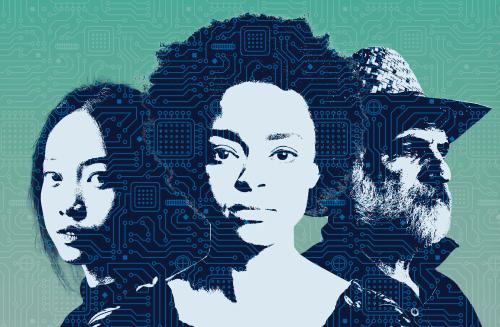This paper was prepared for the June 18, 2020, conference on Automation, Training, and the Middle Class for the Brookings Institution, Future of the Middle Class Initiative.
Economic recovery from the COVID-19 pandemic is unlikely to be fast nor easy. It is increasingly clear, however, that the negative economic effects of the COVID–19 pandemic fall disproportionately on middle- and working-class families. In addition to bearing the brunt of infections and deaths, these families have borne many layoffs and permanent job losses, closures of their small businesses, income losses, and evictions as a result of the pandemic. Initial forecasts of a “v-shaped” recovery were, in retrospect, unduly optimistic.
Agreeing that the short-run shock of the pandemic has turned into a full-blown recession, economists and other analysts have turned their attention to a big question: will jobs actually come back? This is no idle concern. Already we see businesses adapting to the new normal by instituting processes that minimize human contact both between consumers and workers, but also within the businesses themselves. In addition to more employees working remotely, the pandemic has pushed fast adoption and increased innovation in areas such as contactless customer service and delivery, robotic warehouse management and order fulfillment, and automated food service. While the pre-COVID trends in technological adoption were already pointing in this direction, the severity and persistence of the pandemic will likely accelerate the adoption of such technologies. Furthermore, advances in artificial intelligence paired with automating technologies will expand the set of potential tasks that can done by technology, likely resulting in more replacement of human labor. From a business efficiency perspective, this makes sense: humans get sick, machines don’t.
What this suggests is that although the economy will eventually recover, the structure and job composition of that economy may be quite different. This possibility has important implications for workers who previously worked jobs or industries that have been fatally damaged by the pandemic. While some of these workers will almost certainly be able to transfer their skills and experience into other occupations, the other structural changes in how our society conducts our lives as a result of the pandemic may mean that a return to normal may be impossible for some workers.
“…although the economy will eventually recover, the structure and job composition of that economy may be quite different.”
Recovery, however, will bring with it the possibility for new job opportunities. It is therefore important to both get people back to work and to foster the health of any such recovery that we have trained workers who are ready and able to enter newly available occupations. Many of these jobs will require new skills that complement the emergent technology.
A key component of ensuring that workers and firms will be on a same page will be active public policy engagement. This will include committing to investments in community college-based training, fostering public-private partnerships that provide pathways to jobs and apprenticeships. But it will also imply greater investments in support like child care and transitional funding for workers changing occupations or industries as not every worker can spare the time or expense to take community college classes on their own. Other challenges, of course, remain.
Expert Opinions on Training during and after COVID-19
At a recent Future of Middle Class-sponsored event at Brookings, I asked a panel of experts what the key issues policymakers and observers are should be mindful of with respect to training in COVID–19 era given the specter backdrop of automation and AI. The panel included Stephanie Riegg Cellini, Professor of Public Policy, Public Administration, and Economics at George Washington’s Trachtenberg School of Public Policy, David Deming, Professor of Public Policy and Education at Harvard University, and Robert Litan, Nonresident Senior Fellow in Economic Studies at Brookings. Each focused on different and important issues and highlight some of the complications we face in ensuring that we will be able to ensure a trained workforce for the future given the issues presented by the COVID-19 pandemic.
Each of the panelists highlighted different but important issues. Prof. Riegg Cellini focused on the importance of retraining. A major concern, however, is ensuring we have the capacity to do so in a cost-effective way. In particular, Riegg Cellini highlighted the possibility that for-profit colleges may seek to exploit this crisis. As she notes, these colleges are sometimes as much as five times the cost of their non-profit counterparts leading students to take on substantially more debt and often do not provide the same “bang for the buck” in terms of the returns to education as the credentials that they provide are not honored by employers in the same fashion. Finally, she argues for imposition of stronger accountability controls to ensure some protection for students.
Prof. Deming expressed concerns that the US, in addition to having an underdeveloped and underfunded training system for workers relative to other countries with advanced economies, there is, perhaps, misallocation workers as well. It is quite difficult for workers to get retrained after entering the workforce. Deming notes this is partly due to the decentralized and flexible structure of the US post-secondary education system and the lack of sufficient support, financially and directionally, for workers seeking to get retrained. This results in persistent mismatches between the skills that employers desire and the ability of workers to demonstrate these skills. Because of these problems, Prof. Deming is pessimistic about the prospects of many transitional workers and young new entrants to the labor force in post-COVID era.
Finally, Dr. Litan pointed out that the main consequence of the COVID-19 is to accelerate the timeline of automation and AI effects we have already anticipated. That is, it COVID-19 is making the future of work in which we will require fewer and different types of workers arrive faster. Consequently, he believes that many of the policy options that the other analysts have proposed for the future be pursued now. These policies include wage insurance to provide at-risk workers and their families some income protection to potential volatility induced by displacement due to technological change and lifetime training accounts to provide funds to finance retraining. Similar to the other panelists, however, Litan notes these benefits need to be paired with better information on industry trends and employer needs to promote good decision making on the part of workers.
COVID-19 and the Middle Class
The economic effects of the COVID-19 pandemic presents a unique threat to the middle class. The pandemic is accelerating structural changes in the economy, disrupting labor markets, and exacerbating existing inequality. It is imperative that policymakers push for investments in workers and institutions that help to more closely tie worker skills to employer needs as the economy recovers after COVID-19. The Future of Middle Class Initiative at Brookings will continue to explore these issues in the subsequent months. Please continue to visit this space, and if you haven’t already, please sign up for our newsletter.






Commentary
Training during and after COVID-19
September 15, 2020